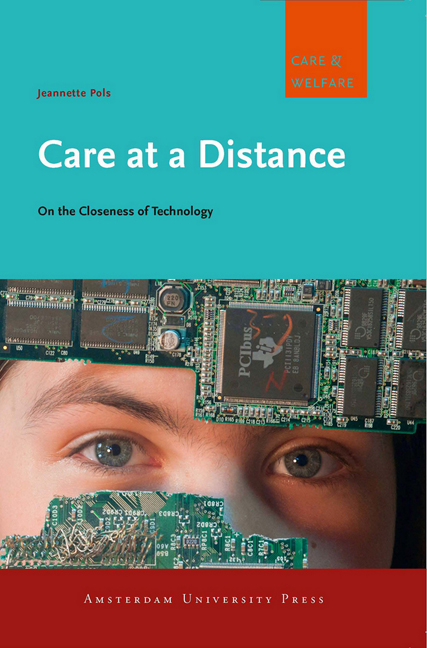Book contents
- Frontmatter
- Contents
- Nightmares, Promises and Efficiencies in care and Research
- Part I Norms and Nightmares
- Part II Knowledge and Promises
- Part III Routines and Efficiencies
- Conclusions: On Studying Innovation
- Acknowledgements
- Appendix: Projects Studied for this Book
- Notes
- References
- Index of Names
- Index of Subjects
6 - Zooming in on Webcams: On the Workings of a Modest Technology
Published online by Cambridge University Press: 03 February 2021
- Frontmatter
- Contents
- Nightmares, Promises and Efficiencies in care and Research
- Part I Norms and Nightmares
- Part II Knowledge and Promises
- Part III Routines and Efficiencies
- Conclusions: On Studying Innovation
- Acknowledgements
- Appendix: Projects Studied for this Book
- Notes
- References
- Index of Names
- Index of Subjects
Summary
Doing invisible work
The previous chapter discussed the important role that webcams play when people with COPD exchange and develop their practical knowledge. The webcam gave access to knowledge and directed people to develop practical knowledge together. However, in contrast to the monitoring device in Chapter 4, the webcam did not seem to do much to shape the content of the exchanged knowledge. Instead of specifically defining, say, deviant measurements as problems to care for, the webcams seemed to leave the definition of problems open to the people using them. The technology was behaving modestly. But just how modest is a webcam?
In this chapter I look closely at the more hidden and seemingly less rigorous ways in which webcams do structure care and contribute to the process of fitting. The aim is to learn how this open, unassuming technology tames and structures conversations, albeit not deterministically. I analyse ‘close-ups’ of the webcam directing routines and perceptions in care practice, influencing what that care came to be about. I quote users’ experiences and analyse how both users and researcher observe the workings of the webcam. How does the webcam help create particular situations and experiences? How does a webcam ‘work’ in the practice of people with COPD?
Webcam practices
For the analysis I mainly use material from the rehabilitation clinic for people with COPD or asthma. Another set of material comes from a homecare organisation caring for patients suffering from severe COPD. In the rehabilitation clinic, patients volunteering to participate in the project received a computer with a webcam at home on their discharge from the clinic. They could use the webcam to keep in touch with their main carer in the clinic, the social worker. And, as I described before, they could also connect to the patients they had spent time with in the clinic as well as send email and surf the internet. The patients received the webcam for up to three months of follow-up care.
In the homecare organisation, the specialist nurse used the webcam to call on COPD patients every week. Here, there was no time limit on webcam use; nurses kept an eye on their patients as long as both parties thought it was useful.
- Type
- Chapter
- Information
- Care at a DistanceOn the Closeness of Technology, pp. 99 - 114Publisher: Amsterdam University PressPrint publication year: 2012



